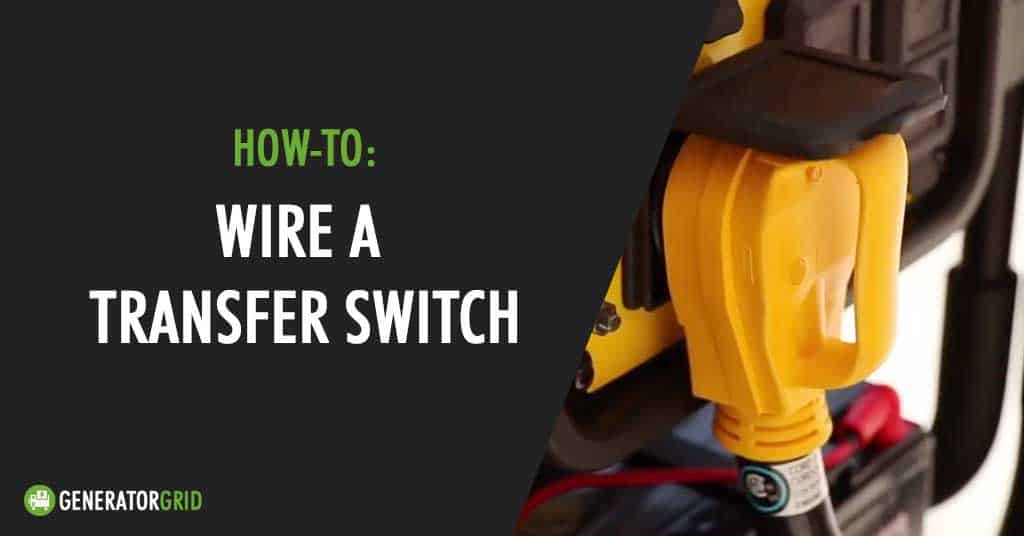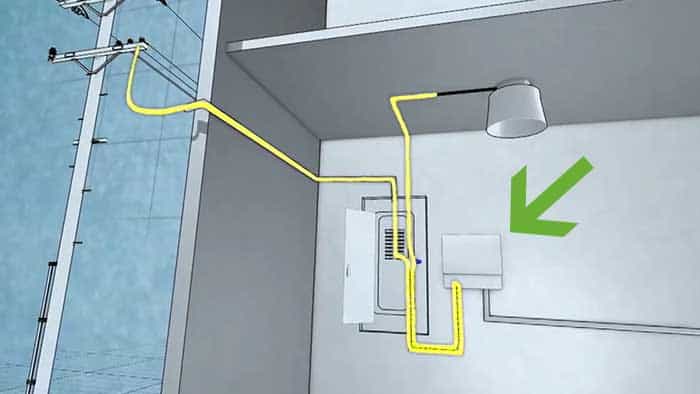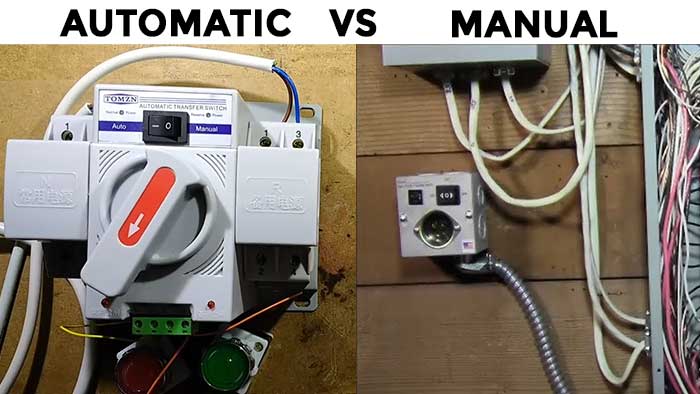Last Updated on October 19, 2022 by Manager Access

Want to add a portable generator as a backup power source to your house? There are a few things you need to know before making the jump.
The most important is the transfer switch.
Not only are there safety precautions to follow when installing a transfer switch, there are also important guidelines to follow for code regulations for your home.
In this guide, I will be discussing what a transfer switch is, types of transfer switches, which switch is best for your home, and how to use it to transfer power from your generator to your home.
After this guide, you will be ready to buy the right transfer switch for you and know how to get it properly installed.
What Is a Transfer Switch?

Image credits: This Old HouseA transfer switch is an electrical switch that transfers electrical power between two sources.
In our case, an automatic transfer switch (ATS) is installed between your home and the generator near the electrical panel.
This transfer switch allows your portable generator to power the circuits you choose in the event of a power outage.
With a transfer switch installed, you eliminate the need for extension cords for each individual appliance, which makes for a safe, up-to-code installation.
Do I Need a Transfer Switch for my Generator?
While a transfer switch is technically not necessary, let’s consider why it’s a good idea when connecting a portable generator to appliances in your home.
- It is required by the National Electric Code.
When using a portable generator to power appliances in your home, the National Electric Code (NEC 700.5 and 701.5) requires you have a properly installed transfer switch.
This is especially important if you plan to sell your home in the future, as improper installation is a code violation.
- It is the easiest way to power your home during a power outage.
Since most of your important electrical appliances, like air conditioning units, furnaces, and water heaters, are hard wired, they cannot be connected to a generator by an extension cord.
Also, having to find, untangle, and run extension cords during a blackout should be the last thing on your mind.
A transfer switch allows for the power to instantly switch over to the portable generator during a power outage for a quick, easy, and reliable alternative power source.
- It is the safest way to connect a portable generator to your home.
Using extension cords can cause back feed from the power traveling back down the utility line.
This increases the risk of fire or electrocution which could result in serious injury or death.
What Should I Look for in a Transfer Switch?
With the vast selection of transfer switches available, there are a few things you want to look at when selecting the best one for you.
I have made this easy with a quick guide on what to look for.
Type
There are two main types: manual and automatic. We will dive into the differences below.
Comprehensive Kits
To ensure that your installation is quick, easy, and includes all the correct parts, having an all-in-one kit is essential.
Most switches are sold as a kit; however, double-check to prevent having to piece things together.
Wattage Rating
When looking for a transfer switch, one of the most important requirements is the number of running watts it can support.
It is crucial that you determine which circuits you want to power through your switch and calculate the number of watts it will take to run them.
UL/CUL Certifications
Most brand name switch kits will have these certifications, but it is a good idea to double-check to ensure they are up to code specifications.
Warranty
As with any purchase, you will want to check to see how well the company stands behind their products.
With anything handling a large electrical load, it is nice to have peace of mind.
Types of Transfer Switches

There is plenty to learn about transfer switch types: open-transition, closed-transition, and delayed transition switches.
These are very important in the business and office settings, but for this article, we will focus on home use only.
For home applications, we will consider the manual and the automatic transfer switches.
Each has its advantages and depending on your budget and application, you can select which will best fit your needs.
Manual Transfer Switches
A manual transfer switch allows you to manually change the power source from the grid to the generator with the flip of a switch.
These switches are much less expensive than automatic transfer switches but you must flip your switch during the power outage.
They also allow you to manually manage the amount of load on your generator to prevent overloads.
Pros
- Inexpensive: Manual switches are less expensive than their ATS counterparts.
- Easy to control loads: With switches on each circuit, you can control the load that your generator is under to prevent overloading.
- Easier to set up: With fewer moving parts and no programming needed, a manual switch is much easier to install.
Cons
- Requires manual switch flipping: In the event of a blackout, you will be required to manually flip the switch to allow your generator to power your home.
Automatic Transfer Switches
An automatic transfer switch allows you to automatically switch the power source from grid to generator as soon as you lose power.
Additionally, these switches can be programmed to automatically power the highest priority circuits during a blackout.
But with convenience comes cost, and these automatic transfer switches are no exception. With more features & higher maximum watt ratings, automatic transfer switches are generally priced higher than manual transfer switches.
Finding the right transfer switch for your home will depend on your budget and accessibility of your breaker box (or location of switch). There are many options on the market that offer a wide selection of options. I will look at the top manual and automatic switches for a general guideline on my top picks. The Reliance Controls Corporation 31406CRK is an Amazon customer favorite for many reasons. This competitively priced, all-in-one manual transfer switch kit includes everything you need to safely and effectively transfer power from your generator to your home with ease. Features: This kit includes a pre-wired transfer switch with wattage meters, 10-foot power cord, 30A power inlet box, wire connectors, and extra 20A plug end. For versatile applications, the indoor/outdoor compatible EmerGen EGS107501 is the solution. Many manual transfer switch boxes are meant to be mounted indoors, making them out of the question for those who require an outdoor mounted box. This is where this transfer switch really outshines the competition. Features: The included nema 3R rainproof power inlet box keeps your connections safe while allowing for a versatile mounting location. The 51410C is not a solid competitor only because it can be used up to 12,500 running watts. The simplistic designs allow for quick and easy installation in both home and office settings. This manual switch kit features a high quality, powder-coated steel box, six combination knockouts, re-settable branch rated circuit breakers, and non-defeatable double-throw switches. Features: The Generac RTSW200A3 is an all-in-one automatic transfer switch built to power a whole home or small office. This 200 amp, 120/240v single-phase rated transfer switch features a convenient service disconnect to allow for easy maintenance or repairs. The Nema 3R rated enclosure protects your switch while keeping it easily accessible. Features: Wiring a transfer switch to your home is a process we suggest leaving up to the professionals, but if you don’t mind tackling it yourself, here is a quick overview. Disclaimer We hope that this guide has given you the information you need to decide which transfer switch to choose and how to install it. A transfer switch is a great investment to help restore power in the event of a power outage where important appliances must keep running. Since there are so many styles and applications available, I want to hear your first-hand experiences. Have you used a transfer switch on your home? What kind of situations has a transfer switch helped you in? Scott Krager purchased generatorgrid.com in the summer of 2020 and quickly began to buy every generator under the sun! He currently has over a dozen generators and the number is growing quickly. He lives in Portland, OR near his family and friends. GeneratorGrid.com is an independent review business. I am not affiliated with any manufacturers and do not accept paid reviews. When you buy through my links, I may earn a commission which helps me purchase more generators for testing. - Scott Krager
Pros
Cons
Best Transfer Switches: My Recommendations
1. Reliance Controls Corporation 31406CRK – Most Popular Manual Transfer Switch
2. EmerGen Switch 10-7501G2 – Great for Indoor or Outdoor Applications
3. Reliance Controls Corporation 51410C for Generators up to 12,500 Running Watts – Quick and Easy Installation
4. Generac RTSW200A3 – Most Popular Automatic Transfer Switch
What Is Grounding?
This is a general guideline and I assume no liability for property damage or injury incurred as a result of any of the information contained in this article.
Conclusion



Any recommendation for an automatic transfer switch for a 7500 watts?
Well, this description leaves me puzzled: With the instructions referring to “turn off the main power” and “turn your main power back on”, it doesn’t sound like such an install has any means of preventing accidental back-feed, which is kind of the whole reason for the switch.
If this switch only serves to connect the GenSet to a specific set of breakers in the service-entrance panel, those breakers would also have to be switched off to prevent back-feeding the rest of the panel during generator operation.
Am I missing something?
With this logic, how would use of a switch in the suggested manner be any different than just wiring the GenSet directly into the main buss and manually throwing the main and the individual circuit breakers for the circuits I don’t want powered?
I honestly was of the impression that a transfer switch was a dressed-up DPDT switch that physically could not permit simultaneous connection of the public power grid AND the private generator. I also was of the impression that back-feeding the grid (aside from the safety issue of the stray current on an assumed cold circuit) would likely damage the generator or control circuits when the grid was re-energized, due to the lack of phase synchronization.
Unless the phase, voltage, wave-form, and polarity are all within a small fraction of the grid values, there would be strong adverse current flows.
If the phase was 180° off, the direct short currect would be at double the generator’s maximum output: That just couldn’t be good.
The transfer switch testing requires you to “turn off the main power” as a means of simulating an outage and allowing the connection to be tested on the GenSet.
Testing can be completed with the main power energized but will not indicate if you have done the job correctly. All transfer switches are Break-Before-Make switches which will not allow an interconnection between GenSet and the load center.
With a properly connected transfer switch there is no way to back-feed either power source.
I have an ATS (Generac 200A 120/240 1P NEMAS). Can I hook it up and run a portable generator (15,000kw) through it using a 50 amp hook up plug?
Well it’s kind of overkill, but yes you can but be mindful of the bonding, if your gernerator’s neutral is bonded to the frame it’s a NEC violation as that transfer switch doesn’t transfer the neutral line. Check your generators manual to see if it’s bonded or floating.
Thank you for the information. Am I correct in assuming that I can use a generator rated at 9KW (or higher) with your first transfer switch, which is rated at 7.5KW, provided I ensure that my loads do not exceed 7.5KW? If the answer is no please explain why not. Thank you.
I have a Ford generator rated 9000 running watts , it has a three prong turning lock outlet for 120 volts 30 amp(L5-30) and a four prong outlet 120/240 volt 50amp(14-50) , I bought a Generac transfer switch 50 amp rated only compatible with 120/240 volt generators , the question is what wire gauge should I use between the generator and transfer switch and which outlet should I use in my generator for that?
Thank you for this article.
I have a question and am not sure who can answer it.
I have a small portable generator Westinghouse iGen4500DF which does not produce 240V power and has no L14-30 outlet. It only has 2 regular 5-20R 120V household outlets and 1 TT-30 30Amp outlet.
Are there any transfer switches I can plug it into?
I only want to run some lights, cable modem, and fridge in a power outage and can get by without 240V during outage.
I’m considering buying this same generator for this purpose and have the same question. Did you ever find out if it could be plugged into a transfer switch?
Concerning grounding! Does the transfer switch (panel) have to have its own ground rod and /or connection to cold water pipes?
Your comments are very helpful! I am interested to find equipment to start a Honda 6KW, electric start generator and operate the transfer switch when the grid goes down.
I have a older generator , 5500w output with two 110 outlets and one 220 outlet is it possible to use a manual transfer with this generator? It doesn’t have the four prong connector type plug that newer ones have.
Until we decided we needed at least a portable generator on hand we had no clue how (somewhat) complicated it would be to actually use! Your article is a lifesaver and now we have the basics! Time to call a certified electrician to have a transfer switch installed!
Can you use an automatic transfer switch on a portable generator with a choke? I had a 16kw Generac which failed after not to much run time. The price to replace the unit was to high to replace. Can I use the same automatic transfer switch on a 13000watt dual fuel duramax which I am going to convert to a trifuel to utilize natural gas and build new housing with ventilation. The problem is the duramax has a choke. Will it work?
following! I am in same boat. I bought the house with a generac “automatic” transfer switch installed already with a big 240 plug outside. the prior owner must have used with a portable generator and took it with them. The transfer switch has around 10 receptacles which is fine but there is no “grid to generator” switch. There is a transfer switch on the main breaker box but its in the on position which seems odd to me since the utility power is on. Unless that is the set up for an automatic transfer switch.
Thomas why would a choke start affect the connection? just choke the motor, start the motor then plug it in right? I am looking at the duramax 13,000 and hope it will run the AC in a emergency.